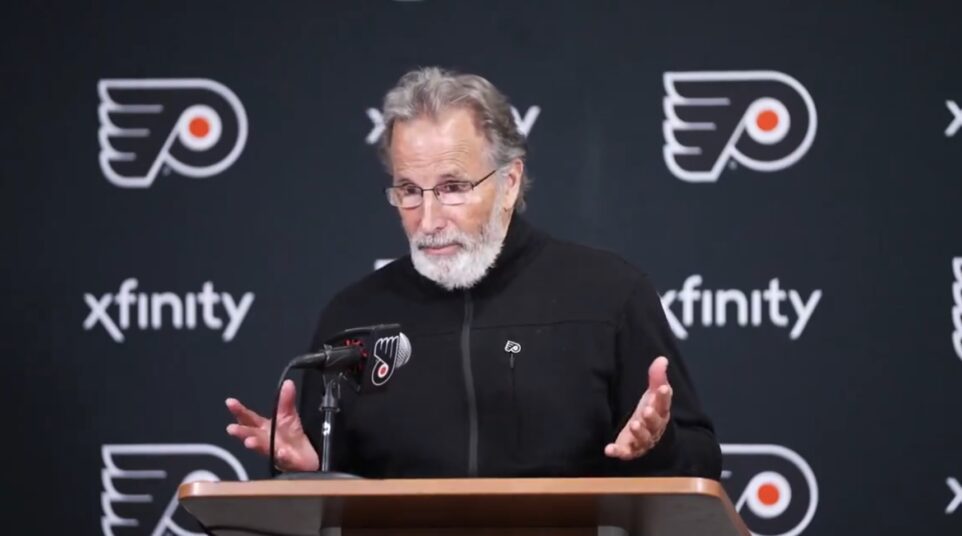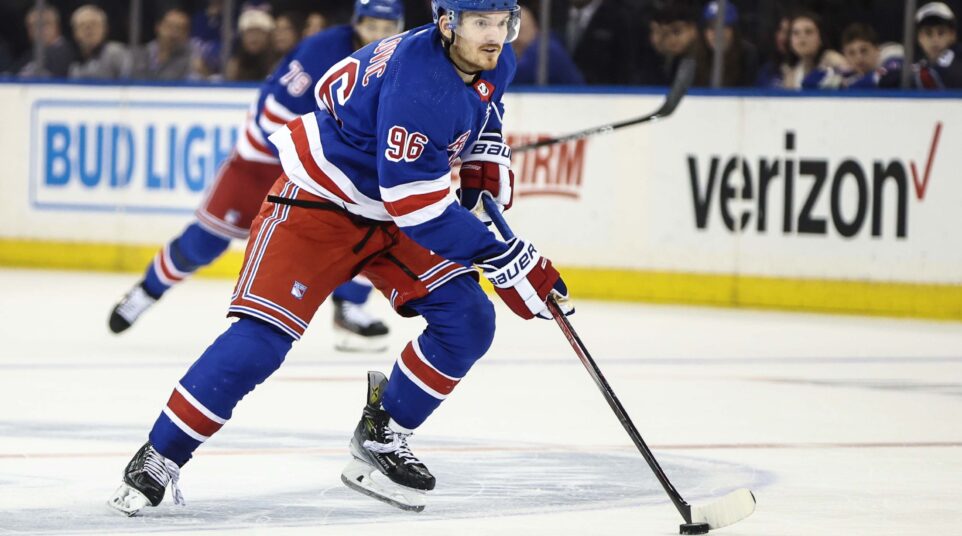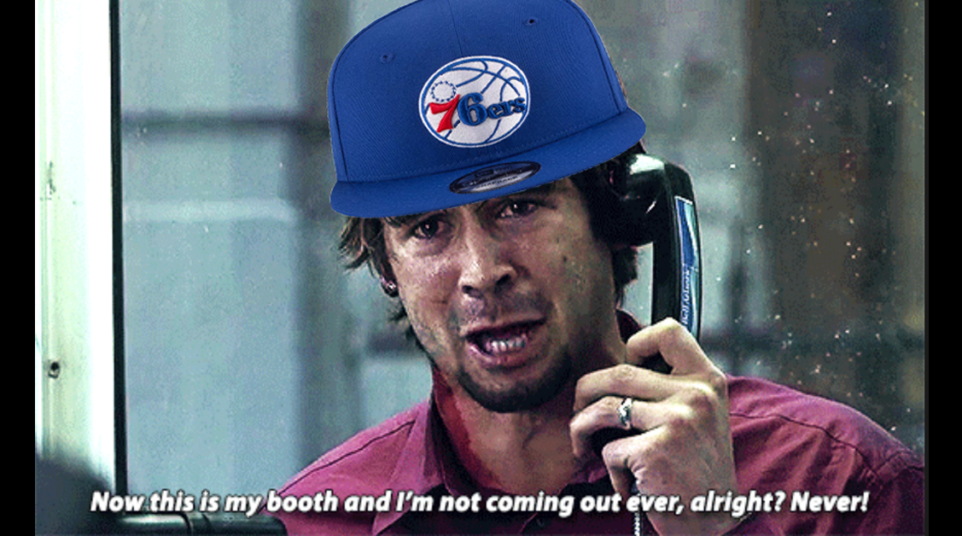The Definitive Phillies Collapse Guide
Photo from reader Tommy, who sent these Phillies Fan Appreciation Day postcards to Amaro
I’m going to break your heart. Again.
It was poetic justice (written in the stars?) when Ryan Howard stepped to the plate on Friday night for the Phillies’ final at-bat of their historic 102-win 2011 season. He made the final out of 2010 by watching a Brian Wilson slider nip the edge of the strike zone, and now he had a chance to redeem himself.
Freeze.
Sadly, by this point, I was only rooting for Howard to not strike out to end the season. It was a small battle in the lost war. When he hit a grounder to second, I actually felt a sense of relief. At least we wouldn’t have to deal with the painful image of Piece standing at home plate for the next six months. Then my eyes ran down the line, unlike Howard, who was writhing in pain on the ground. Not only did he commando roll his way into the offseason, but he also ripped his fucking Achilles into two separate pieces. If last year’s image was haunting, this year’s was the baseball equivalent of seeing Kathy Bates topless in About Schmidt.
As such, Howard’s final, Achilles blowing at-bat will be seared into our minds like the time our seventh grade teacher showed us The Miracle of Birth without advanced warning of expanded snatch.
Some things you just can’t take back, man.
But make no mistake… the Phillies were cooked long before Piece stood before the surprisingly tattooed Chris Carpenter.
There are many theories on why the Phillies failed to reach their fourth consecutive NLCS. Some of them are hogwash (first time using that on site- really excited), some are valid. All will be discussed.
1) 2008 was a fluke
Oh no he did-en!, that’s my team!
Yes, I did. And you’re just going to deal with it.
I’m 28-years-old, the Phillies’ 2008 World Championship is the only championship I’ve seen in my lifetime (shut up, Phantoms fans). So I get it. Believe me, I get it. But humor me for a second: Jimmy Rollins, Shane Victorino, Chase Utley, Ryan Howard, Carlos Ruiz are all heroes. We (and this includes Charlie) have been incredibly forgiving of their faults. Even when we’re mad, we quickly overlook their mistakes. For instance, Rollins says dumb things and he isn’t a good leadoff hitter– J-Roll!™
Utley has a small frame and loses strength and weight during the season. His slugging percentage has decreased each of the last four years– Blinders, baby!
Howard strikes out too much and only makes contact on roughly 67% of pitches he swings at. That’s 13 points below the league average— Who cares?
Ruiz is a below average hitter– Chooch!
So, really, because we place these guys on a very high pedestal, they’ve become caricatures of themselves and we fail to recognize that they’re part of a very flawed lineup. Let’s face it, their 2008 success was largely based on the fact that they all peaked at the same time, in a way that would make the marketers of K-Y Yours and Mine jealous. Remember, in baseball, 29 is the age at which a player is usually at his best.
Check out the ages of the typical starting lineup in 2008:
29
27
29
28
31
29
33
29
Good lord. It’s a simultaneous explosion of performance. No wonder we saw a dripping wet Chase Utley smoke a cigar when it was all said and done.
The ages of this year’s lineup were much different:
32
30
32
31
28 (Pence)
39
36
32
That’s an extra 25 man years. If 2008 was a sexy baseball concoction, 2011 was old, married humping. The opportunities for sustained performance were significantly more rare this year. It turns out, the 2008 lineup wasn’t loaded with would-be Hall of Famers, the way some of us thought; rather, it was filled with really good players in their primes, many of whom played together for several seasons.
And even with everything falling into place that season, a number of other factors had to work in the Phillies’ favor. Their rotation was lined up perfectly for every postseason series. Had Rollins not turned the J-Roll™ to Utley to Howard double play on the second to last day of the season, Cole Hamels would have been forced to pitch the next day, rendering him useless until Game 3 against the Brewers. The Phillies also – by no fault of their own – got to play the Rays instead of the powerful Red Sox. That’s not to take anything away from the accomplishment, but everything broke right for them. If they didn’t win it all that year, would we give them such a long leash? Probably not.
But that should only affect fans, not the manager, right? Right?!
2) Charlie Manuel is too loyal
Manuel’s greatest strength – and what endears him most to his players – is his loyalty. Sometimes it pays huge dividends, like when he stuck with Halladay, who was up around 120 pitches, in the eighth inning of Game 5 against the Cardinals. Many managers would have turned to a loose Madson (or perhaps even Lee or Bastardo) to face Lance Berkman with the bases loaded in a one-run game. Manuel, in effect, said to the Cardinals that if they were going to go for the kill shot, they were going to do it against Halladay.
Doc got out of the jam.
It’s those sorts of guts first, brains second moves that have often worked in the Phillies’ favor. Even though Brad Lidge hocked up Game 4 of the 2009 World Series (thanks in part to Johnny Damon briefly descending from the cross), Manuel’s decision to stick with his struggling closer is what helped the Phillies get there in the first place. Lidge came up big in both the NLDS and NLCS that year, cementing two victories for the Phils.
Manuel’s loyalty often comes back to haunt him, however. There is no reason why Polanco, Ruiz, and even Ibanez shouldn’t have been pinch hit for in Game 5 against the Cardinals. Polanco was very obviously dealing with injury and cornering the market on softly hit ground balls to shortstop. And, if you believe StatSheet’s ranking methods, John Mayberry Jr. was the Phillies’ second most valuable hitter this season– he deserved more opportunity than he was given.
Other examples of Manuel being too loyal include the much more publicized decisions to start Joe Blanton in Game 4 of the 2009 World Series and 2010 NLCS– both losses.
We love Charlie for managing with his heart, but it may have cost the Phillies this time. Cliff Lee should not have pitched the seventh inning of Game 2 last Sunday– he gave up the game-winning hit to Albert Pujols.
Had Manuel shown more urgency in any one of those situations, the Phillies may have won the game… or the 2009 World Series or 2010 NLCS or 2011 NLDS. Hindsight is perfection, but the moves were questionable at the time, too.
3) I’m Hunter Pence, I offer you my protection
This one falls on Charlie, as well. It’s this simple: I didn’t like Pence hitting ahead of Howard.
When Pence came to the Phillies, fans (and presumably Charlie) were thrilled to have an all-star hit behind our slugging first baseman, and rightfully so. In Pence’s first four games with the Phillies – all batting fifth, behind Howard – The Big Piece was 9-for-17 with 9 RBI. While those numbers came back down to earth, it was apparent that Pence’s presence had some effect on Howard, even if it was psychological (Howard actually saw fewer fastballs).
There were 31 total games in which Pence batted fifth, behind Howard. In those games, Howard was 33-for-119 (.276) with 30 RBI. But with Pence batting third, in front of Howard, like he did in all five playoff games, The Big Piece was 11-for-55 (.200) with 12 RBI. Ouch.
Another tidbit: When you line up the 31 games in which Pence hit behind Howard, only once (the final two occasions) was Howard held hitless in consecutive games with that lineup. In the 15 games Pence was in front of Howard, Piece strung together four and three-game hitless streaks, respectively, including the final three games of the postseason.
There are other factors at play here, though: Pence batting third was a practice not seen until early September, when Howard started suffering more from his heel problem. And Pence, while consistent, actually fared better hitting third than he did fifth.
From a practical standpoint, batting Pence third forced Victorino down in the lineup, to the fifth spot. Shane Victorino should not be batting fifth. He’s the fastest player on the team and – by far – the best get on base and make goofy shit happen happen guy. Having Rollins and a withered away Utley hitting ahead of Pence and Howard strings together too many predictable players and allows opposing pitchers to get to the “back half” of the lineup one batter sooner. Batting Victorino fifth basically forces him to hit home runs, because Ibanez is all-or-nothing and Polanco and Ruiz sure as hell aren’t driving him in (more on Polly in a second). As such, Victo only scored two runs in five games against the Cardinals, despite leading the team in runs scored (95) during the regular season.
Moving Pence not only impacted Howard, but it also affected the whole fucking lineup, forcing every player to swing for the fences.
Need more evidence (you don’t, really) of the prolonged bouts of shit? In the five-game NLDS, the Phillies had separate streaks of 13 and 10 consecutive scoreless innings. Not to mention scoring only one run in the – brace yourselves here – final 17 innings of the best season in team history. Pure pain.
The team’s struggles are not all to blame on the batting order, however. Perhaps the SABR nerds were onto something with Howard. While I’m never going to discount the value of having a guy who can (and does) change a game with one swing of the bat, advanced metrics provide a way to apply some certainty to a very uncertain game. When so many random moments – like Ben Francisco’s three-run home run – occur, having even a modicum of guaranteed performance can go a long way. This is what advanced metrics aim to do. They can’t predict what will happen, but they can give you a pretty good idea of what to expect. Unfortunately, with Howard, that expectation is either a game-changing home run (Game 1) or a pile of shit in the bed (Games 3-5). Surrounding him with reliable, on-base type players would be a wise decision.
4) Blame Cliff Lee
Lee wasn’t brought here to bridge the Madison Bumgarner gap, he was brought here to bridge the Joe Blanton gap. Having Lee assured the Phillies – if healthy – the luxury of four frontline starters in a playoff series. Given his stellar postseason record until last year’s World Series (he’s given up 14 earned runs in 17.2 innings since), Lee was expected to perform in October. This year, he was given and 4-0 lead in Game 2… and blew it.
He said after the series that the Phillies could have swept the Cardinals if he upheld the lead. While Game 3 may have played out differently if the Phillies held a 2-0 advantage, it’s safe to assume that if Lee didn’t give up five runs in six plus innings last Sunday, the Phillies would probably be playing a game tomorrow night. And Thursday. And Friday.
…
It wasn’t all Lee’s fault.
Roy Oswalt was handed a 2-0 lead in a clinching game. He blew it, giving up five earned runs in six innings.
Even Roy Halladay, who pitched brilliantly for much of his two starts, wasn’t his usual, near-perfect self. Both in Games 1 and 5, he put the Phillies in a hole before they ever got a chance to bat. They dug themselves out (and then some) in Game 1, but went into swing for the fences mode early in Game 5, thanks to an insurmountable one-run deficit. Had Halladay not allowed the CBP balloon to pop so early in Game 5, perhaps things would have turned out differently. There should be no blame assigned to Doc, but twice our true Ace put the team behind before he could work up a sweat.
The Phillies were built to go only as far as pitching took them, and despite their massive hitting woes, the Phillies had a leads of 6, 4, 3, and 2, respectively, in four of the five games. They lost half of them.
5) Ruben Amaro is only good for the "big move"
One of the main reasons the Phillies won in 2008 – besides having a lineup full of players in their prime – was the contributions of low-to-mid-level players acquired by Pat Gillick: Blanton, Pedro Feliz, Matt Stairs, Jayson Werth (at the time), Eric Bruntlett (scored the winning run in two World Series games), Scott Eyre, and, oh yeah, Jamie Moyer. None of those acquisitions caused widespread euphoria, like Amaro’s Lee, Halladay, Oswalt, Lee, and Pence moves… but they proved every bit as important. Ruben hasn’t shown us that he can make those team-shaping moves.
The Phillies’ best role players this season were, for the most part, from the minors: Antonio Bastardo, Vance Worley, Mike Stutes, and Mayberry. Outsiders like Michael Martinez, Wilson Valdez, Ross Gload, and Brian Schneider have proven to not be adequate postseason options. Only Ben Francisco – out of nowhere – made a significant contribution, and he was a throw-in with Lee in 2009.
Part of the reason Manuel was forced to stick with Polanco and Ruiz is because he didn’t really have viable replacement hitters besides Mayberry, who plays first base and left field. Basically, for a 102-win team, the Phillies lacked depth at many positions. That, or Manuel didn't trust many cards he was dealt.
6) They killed themselves
For the second year in a row, the Phillies allowed their eventual foe to make the playoffs. Last year, they swept the Padres late in the season, allowing the Giants to squeak into the postseason. This year, they swept the Braves – twice – in September, a noble action that allowed the Cardinals to clinch the Wild Card on the last day of the season.
While you obviously can’t play for matchups, it is ironic that in each of the last two seasons, the teams fans feared most turned out to be the Phillies’ Achilles’ heel (I… I’m sorry).
The Phillies also clinched too early. After sewing up the division, they lost their next eight games and 11 of their final 17, including the playoffs. Whether you make light of that situation or not, you can’t ignore the fact that the Phillies were shutout in three of their final 17 games and held to one run on two other occasions. Once the switch was turned off, it was never turned back on.
7) Injuries
Howard struggled with a sore ankle for much of the last two months of the season, it is what most likely led to him blasting apart his Achilles on the final play. It’s hard to say how much it affected his hitting, though, because he did have some productive games while hurt.
Utley dealt with a knee issue early on and a concussion in September. While he was supposedly healthy in the playoffs, he’s a guy that always loses his strength and power as the season carries on. His injury had to put a damper on his workout routine, especially his legs and core, which are the foundation for his quick swing. It was fairly obvious that Utley was nothing more than a singles hitter by the end of the year. That ball he lined to center to leadoff the ninth inning of Game 5 would have been a home run in years past or earlier in the season. His strength was simply gone.
Further, Pence had a sports hernia. Ruiz took a beating behind the plate. And even Hamels needs surgery to clear out loose bodies in his elbow.
Perhaps the guy most impacted by injuries was Polanco, who, since June 28th, had only three doubles and one home run in 181 at-bats, including the playoffs. Production!
8) It was a slopfest
Utley getting thrown out at third by Pujols (still a dumb play, don’t defend it), Rollins getting picked off trying to steal second, Ruiz’s decision to throw to second on a bunt in Game 5, failure to run out obviously fair ground balls, rallies killed by caught stealing, Victorino’s dropped catch in Game 2, falling near the track in Game 4, swinging at 3-0 pitches, failure to hit the cutoff man… the list goes on. Just not the types of things winning teams do. Not what we’ve come to expect from the Phillies.
…
The fact is, every one of these theories has merit. The Phillies’ core of stars were significantly less productive in 2011 than they were in 2008 and 2009. Charlie Manuel – while lovable – made critical mistakes. Cliff Lee let the team down. Amaro probably got too caught up in making the front page of the paper. And clinching early impacted the team’s performance down the stretch and going into the playoffs. To make matters worse, every major offensive player dealt with injuries… But none of that should be an excuse for poor, often dumb play during the most important part of the season.
Whatever the issues may have been, all that matters is the end result. And in the last four seasons, the Phillies have seen an inverse correlation between regular season wins (green) and postseason success (red).
You know what that looks like, folks? A big. fat. X.
Ladies and gentlemen, the 2011 Philadelphia Phillies.





